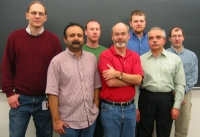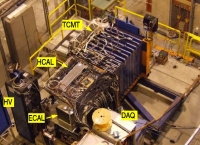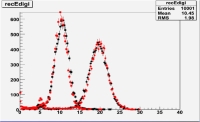 |
 |
|||||||||||||
|
|||||||||||||
|
|||||||||||||
|
Amidst the corn fields in DeKalb Illinois, 65 miles to the west of Chicago, a group of 22 physicists and students, who are members of the Northern Illinois Center for Accelerator and Detector Development (NICADD) at Northern Illinois University, contribute to the International Linear Collider in more ways than one. From beam dynamics to calorimetry hardware to simulation software, the ILC group at NIU covers it all. Because the group consists of such a large number of undergraduate and graduate students, training the future generation of scientists – who may be running the actual ILC one day – is perhaps one of their largest contributions of all. One way that students get that hands-on experience is with the university's Beam and Astrophysics Group, which is currently involved in the design and beam dynamics optimisation of the Fermilab ILC test accelerator. Philippe Piot and co-workers are developing diagnostics techniques for the ILC injectors and bunch compressors aimed at monitoring, measuring and correcting the electron and positron bunch lengths. In parallel to this simulation work, the group is also building a beam physics lab on campus that incorporates a femtosecond class laser and will be used to develop and test beam diagnostics. Eventually, the group will operate a low energy electron accelerator. “We expect to have a fully operational facility by the end of this year,” he says. “We will use our facility to train students who can eventually go on to conduct studies at Fermilab's ILC test beam facility which should be start operation in 2008.” Roughly 25 miles down the road from Fermilab, the NIU group collaborates with the lab on several ILC projects, such as detector R&D. Teaming together with NIU's Vishnu Zutshi, Sasha Dychkant and Jerry Blazey, Fermilab helped construct a calorimeter prototype made of scintillator strip-silicon multipliers. Called the tail catcher muon tracker, this prototype measures the energy at the very end of hadron showers. “Other test detectors catch the initial portions of a shower, and this prototype catches the tail so that energy resolution and complete shower structures can be studied,” Blazey says. With help from Fermilab and DESY, it took NIU two years to construct the tail catcher, which consists of 320 read-out channels. A member of CALICE (Calorimeter for Linear Collider Experiment), NIU sent the tail-catcher to CERN, where it joined two other calorimeter prototypes, the electromagnetic calorimeter (ECal) and hadronic calorimeter (HCal), for beam tests in the autumn of 2006. NIU also contributed to the HCal, which is based on the same technology. “The tests were very useful because we learned a lot about the a new light-sensing technology based on silicon photomultipiers,” Blazey says. “We have a ton of data now, and it is clear that the tail-catcher can be an important component of fine-grain calorimetry.” For the next prototype, NIU hopes to continue the collaboration with Fermilab for their electronics and mechanical engineering expertise to develop a hadron calorimeter and tail-catcher that are easier to mass produce. A fine-grain calorimeter for the ILC, the ultimate goal in developing these prototypes, will allow physicists to separate the charged particles from the neutral ones inside the detector. “It's not easy to do,” says NIU physicist Dhiman Chakraborty. “It's like trees in a forest. When the trees are close together, it's hard to tell which leaf belongs to which tree. That is essentially what we are trying to do.” To separate the leaves, state-of-the-art detector hardware is one half of the equation. Sophisticated software is the other. The NIU team is working closely with other institutions in the U.S., Europe and Asia on simulation and algorithm development projects. NIU physicist Vishnu Zutshi developed a pattern recognition algorithm called Directed Tree. This software can be considered the first step in grouping energy deposits in the calorimeter into clusters that are attributable to the showering initiated by a single particle . “The algorithm looks for 'roots' and 'branches' of a 'shower' to construct a tree,” Chakraborty says. “The development of a hadron shower proceeds a bit like a tree, and in a sufficiently fine-grained calorimeter, it should look like one.” So far the algorithm has demonstrated a strong performance for clustering, but the NIU group would like more test beam data to further verify the simulations. “We are analysing the data taken at CERN, but we are trying to collect more data with different types of particles, energies and angles to compare to what our current simulations predict,” Chakraborty says. -- Elizabeth Clements |
|||||||||||||
| © International Linear Collider |



